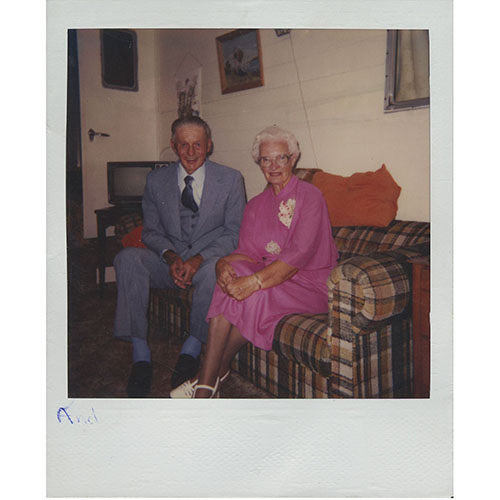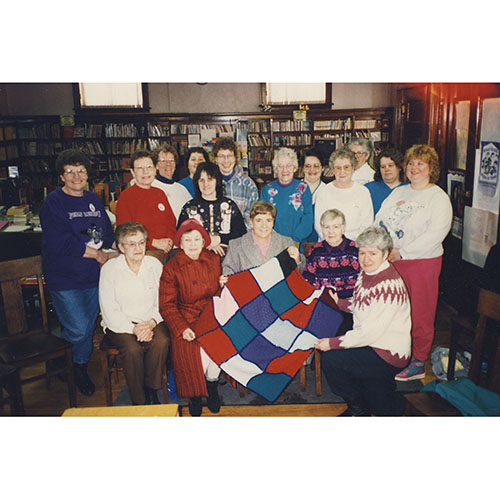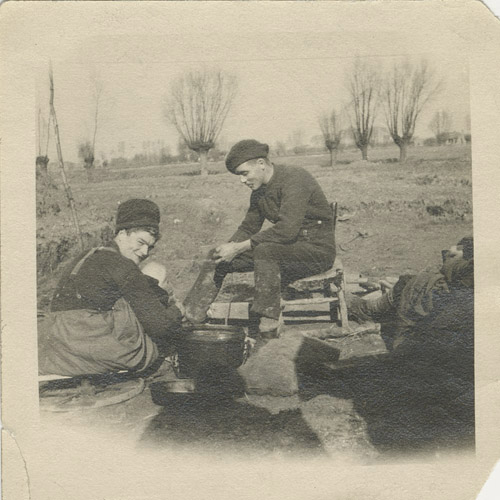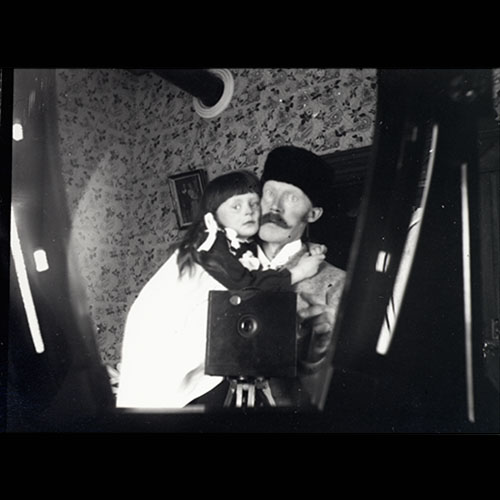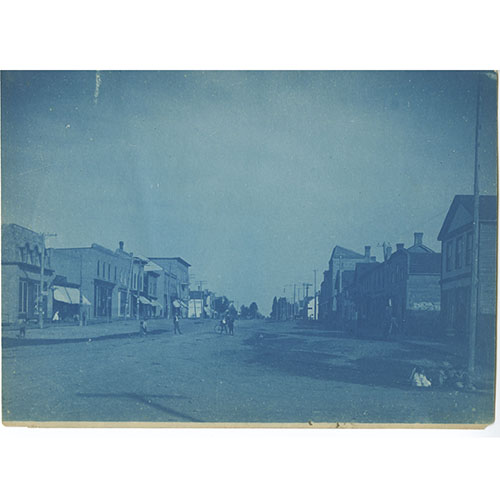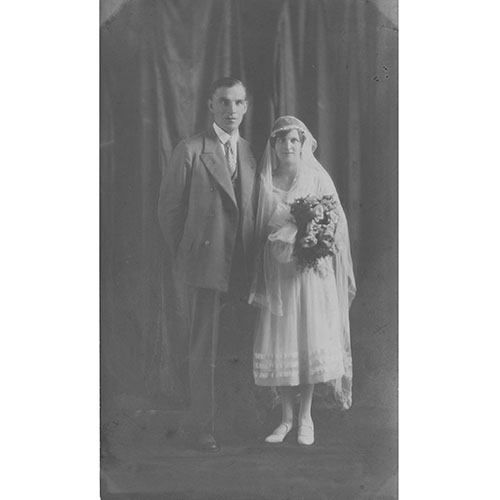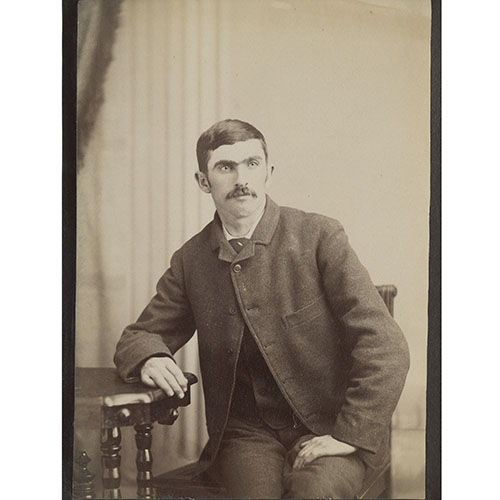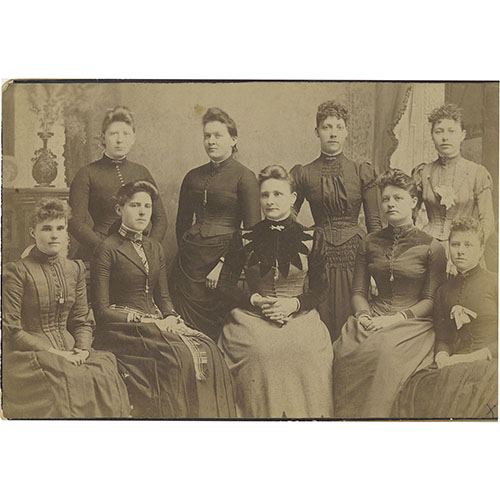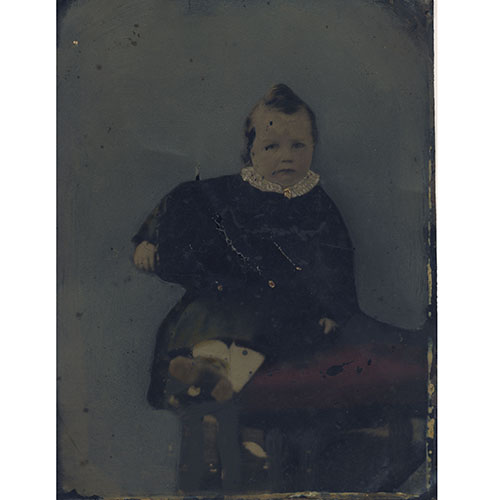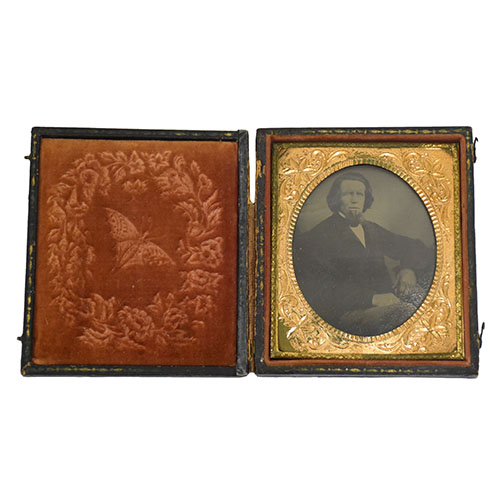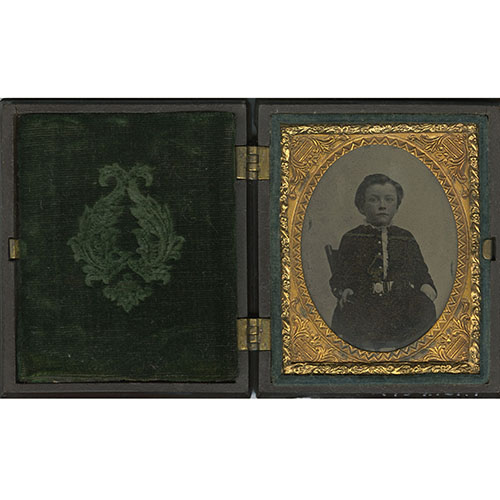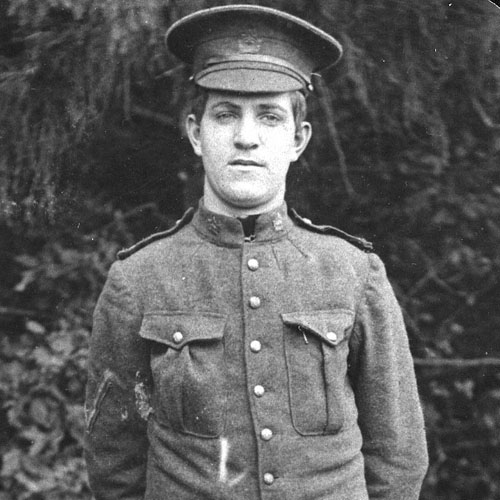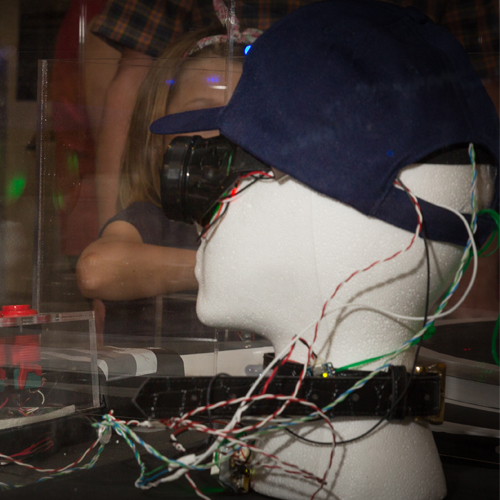Today photography is commonplace, plays an important role in how we interact with others via social media, and serves to preserve memories. With the rise and development of the “point and shoot” camera, photography has become easy medium and something everyone can do. However, with the digital photography age upon us, the science and chemistry of early photography is often forgotten. Photographic materials in the Bruce County Archives, not only serve to visually document the history of Bruce County, but the materials themselves tell a story, making the media just as important to preserve, as the images that are on them.
Early photographers not only had to have a good “eye” for their subject matter they also needed a working knowledge of the chemistry as most plates and photographic papers had to be prepared and sensitized by the photographer just prior to exposure. The first commercially successful photographic process was the daguerreotype which was introduced in 1839. Daguerreotypes are made of highly polished silver coated cooper plates and developed using mercury vapours. The images are one of a kind, and the surface of the image is shiny and appears mirror-like. Since the exposed image just rested on top of the plate, daguerreotypes were most often placed in small cases which protected the image from being damaged.
The next advancement was the collodion process. Collodion is a viscous substance made from nitrocellulose, ether, and alcohol, which was then pour over a plate and made light sensitive by a solution of silver nitrate. Plates developed using the collodion process were exposed and developed while still wet. Collodion was used to create ambrotypes, tintypes, glass plate negatives and collodion print out papers. Several of these types of these photographs are found in the Archives.
Ambrotypes
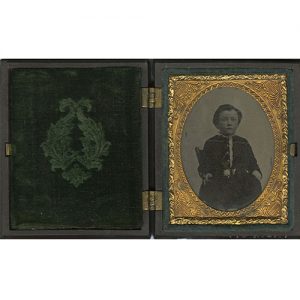 Ambrotypes were popular from the mid-1850s to the mid-1860s and consist of collodion on a glass support. These images are one of a kind, and typically depict portraits. To view the image as a positive, a dark background behind the plate was required. Like daguerreotypes, ambrotypes are fragile and the images were often cased and occasionally tinted. An example of tinting would be making a child rosy-cheeked. This ambrotype of an unknown child is housed within a hinged thermoplastic case and has a decorative brass over mat. The background is a dark green velvet.
Ambrotypes were popular from the mid-1850s to the mid-1860s and consist of collodion on a glass support. These images are one of a kind, and typically depict portraits. To view the image as a positive, a dark background behind the plate was required. Like daguerreotypes, ambrotypes are fragile and the images were often cased and occasionally tinted. An example of tinting would be making a child rosy-cheeked. This ambrotype of an unknown child is housed within a hinged thermoplastic case and has a decorative brass over mat. The background is a dark green velvet.
Tintypes or Ferrotypes
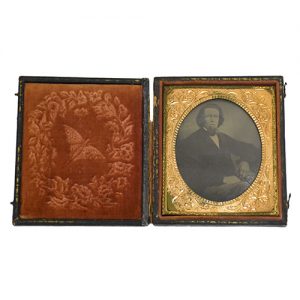 Tintypes, also known as ferrotypes, are photographs on a lacquered or enameled iron support, and were created between the 1850s and the 1920s. Due to the metal plate backing, rather than glass, tintypes are more durable and can be found in cases, albums, paper sleeves or as a stand-alone piece. It was also more affordable, making photography accessible to more than the upper classes. Like other forms of photography tintypes could be tinted. The Archives houses many tintypes within its collection; a testament to how popular and financially accessible photography was to everyone and to the durability of the medium. The cased tintype of an unknown man features a gold-coloured metal over mat. A torn paper on the backside of the plate is dated 1855. The other tintype below features Hughie MacFadyen and has been tinted throughout.
Tintypes, also known as ferrotypes, are photographs on a lacquered or enameled iron support, and were created between the 1850s and the 1920s. Due to the metal plate backing, rather than glass, tintypes are more durable and can be found in cases, albums, paper sleeves or as a stand-alone piece. It was also more affordable, making photography accessible to more than the upper classes. Like other forms of photography tintypes could be tinted. The Archives houses many tintypes within its collection; a testament to how popular and financially accessible photography was to everyone and to the durability of the medium. The cased tintype of an unknown man features a gold-coloured metal over mat. A torn paper on the backside of the plate is dated 1855. The other tintype below features Hughie MacFadyen and has been tinted throughout.
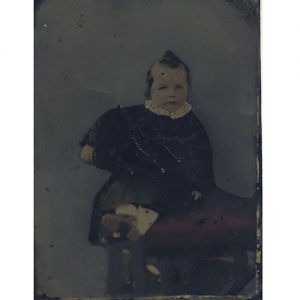
Albumen
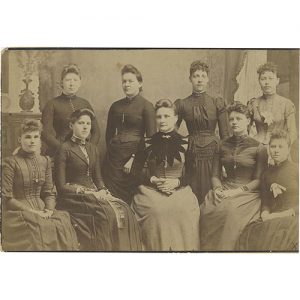 The albumen printing process was created in 1850 and was the dominant process of the 19th century. Albumen prints consist of thin paper coated with egg whites and salt. These were commercially made, and then sensitized by the photographer. The prints are smooth and have a semi-glossy surface. The colouring of albumen prints is brown-purplish tones, but they could be toned other colours. This albumen print dates from 1888 and is Mary Norman of Kincardine’s dressmaking class.
The albumen printing process was created in 1850 and was the dominant process of the 19th century. Albumen prints consist of thin paper coated with egg whites and salt. These were commercially made, and then sensitized by the photographer. The prints are smooth and have a semi-glossy surface. The colouring of albumen prints is brown-purplish tones, but they could be toned other colours. This albumen print dates from 1888 and is Mary Norman of Kincardine’s dressmaking class.
Colloidon Printing Out Paper
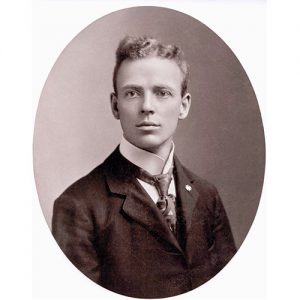 Collodion printing out paper photographs were popular between the 1860s and 1910. These have a paper support – the paper was salted and sensitized with a silver nitrate solution. The image consists of silver chloride suspended in a collodion binder. Typically, collodion printing out papers have reddish-brown to purple-brown tones and a glossy surface. The photo, featuring Benjamin Joseph Burns, dating to ca.1899, was originally printed on collodion printing out paper.
Collodion printing out paper photographs were popular between the 1860s and 1910. These have a paper support – the paper was salted and sensitized with a silver nitrate solution. The image consists of silver chloride suspended in a collodion binder. Typically, collodion printing out papers have reddish-brown to purple-brown tones and a glossy surface. The photo, featuring Benjamin Joseph Burns, dating to ca.1899, was originally printed on collodion printing out paper.
Gelatin Printing Out Paper
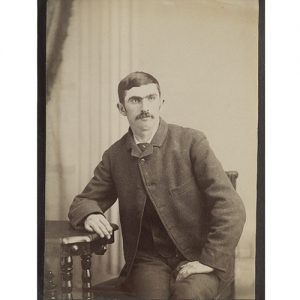 Invented in 1882, gelatin printing out paper became commercially successful in the late 1890s. These consist of silver chloride suspended in a gelatin binder, which is fixed with sodium thiosulfate, or “hypo”. Gelatin printing out paper was used from the mid-1880s to 1910. The gelatin printing out paper print here is John Stewart, the owner of the Paisley Agricultural Works, and dates prior to 1893.
Invented in 1882, gelatin printing out paper became commercially successful in the late 1890s. These consist of silver chloride suspended in a gelatin binder, which is fixed with sodium thiosulfate, or “hypo”. Gelatin printing out paper was used from the mid-1880s to 1910. The gelatin printing out paper print here is John Stewart, the owner of the Paisley Agricultural Works, and dates prior to 1893.
Silver Gelatin Developing Out Papers
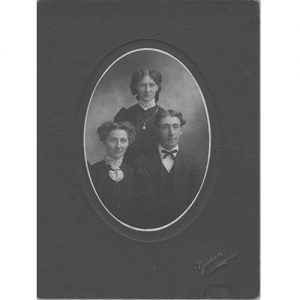 Silver gelatin developing out papers were invented in 1873 and was the dominant photographic media of the early 20th century. The prints are potassium bromide and silver nitrate suspended in a binder of gelatin that coats a paper base. What differentiates this paper from collodion, albumen and gelatin printing out paper, was that it used chemicals rather than sunlight to expose the image. This process was used for a variety of applications including postcards, advertisements, and identification documents. Untoned, the prints are a neutral black and white and could be made to have several different surface sheens, and textures. The portrait featuring three people was created by Chesley photographer William S. Graham, and the other shows “Ab” Ritchie and Sarah Jane Robinson on their wedding day in 1927.
Silver gelatin developing out papers were invented in 1873 and was the dominant photographic media of the early 20th century. The prints are potassium bromide and silver nitrate suspended in a binder of gelatin that coats a paper base. What differentiates this paper from collodion, albumen and gelatin printing out paper, was that it used chemicals rather than sunlight to expose the image. This process was used for a variety of applications including postcards, advertisements, and identification documents. Untoned, the prints are a neutral black and white and could be made to have several different surface sheens, and textures. The portrait featuring three people was created by Chesley photographer William S. Graham, and the other shows “Ab” Ritchie and Sarah Jane Robinson on their wedding day in 1927.
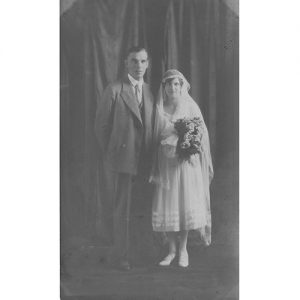
Cyanotypes
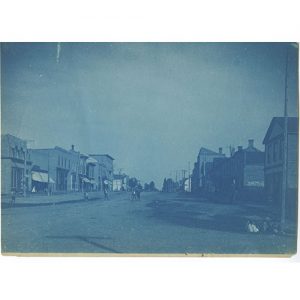 The cyanotype process was an easy and low-cost process that was in use from 1842 to 1950. They rely on the light sensitivity of iron salts and the image is fixed with water. Cyanotypes are Prussian blue, have a matte surface and have visible paper fibres. These are often used for mechanical line drawings, also known as blueprints. The two cyanotypes seen here are of High St. in Southampton, looking east, dating from the 1890s, and Vanstone and Morran’s Furniture Factory, also located in Southampton, and dates between 1885 and 1895.
The cyanotype process was an easy and low-cost process that was in use from 1842 to 1950. They rely on the light sensitivity of iron salts and the image is fixed with water. Cyanotypes are Prussian blue, have a matte surface and have visible paper fibres. These are often used for mechanical line drawings, also known as blueprints. The two cyanotypes seen here are of High St. in Southampton, looking east, dating from the 1890s, and Vanstone and Morran’s Furniture Factory, also located in Southampton, and dates between 1885 and 1895.
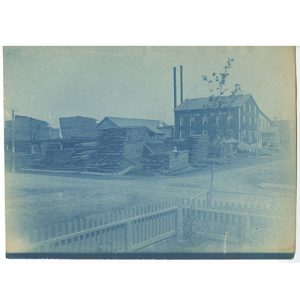
Gelatin Dry Plate Negatives
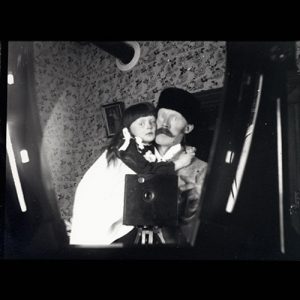 Gelatin dry plate negatives consist of a gelatin-based silver bromide emulsion coated on clear glass plates. Unlike collodion plates, which needed to be prepped just before use and developed immediately after, gelatin dry plates could be stored ready and waiting for when the photographer needed them and could be developed anytime afterwards. This allowed photographers to carry less chemicals with them and they no longer required a portable darkroom. This process also allowed photographic plates to be mass produced and were popular from the 1880s to the 1920s.
Gelatin dry plate negatives consist of a gelatin-based silver bromide emulsion coated on clear glass plates. Unlike collodion plates, which needed to be prepped just before use and developed immediately after, gelatin dry plates could be stored ready and waiting for when the photographer needed them and could be developed anytime afterwards. This allowed photographers to carry less chemicals with them and they no longer required a portable darkroom. This process also allowed photographic plates to be mass produced and were popular from the 1880s to the 1920s.
Found in the Archives is the J.H. Scougall Fonds which contains over 1,500 gelatin dry plate negatives capturing life in Kincardine from between the 1874 and 1922. Subject matter ranges from images of harbour life, parades, streetscapes, sports, townspeople, and even includes a selfie (seen here) taken with the use of a mirror.
To learn more about J.H. Scougall, Click Here
To explore the J.H. Scougall fonds in the online collection, Click Here
Vernacular or Popular Photography
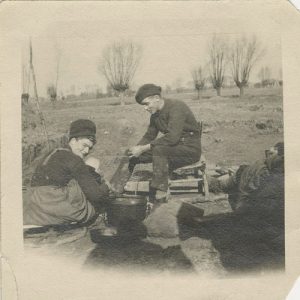 The rise of vernacular or popular photography began in 1900 when the Eastman Kodak Company invented a camera known as the Brownie. At the time, cameras sold for a dollar, and the film for 15 cents. With a slogan like “You Press the Button – We Do the Rest”, the modern age of “point and shoot” photography was born. The flexible film these cameras used was first marketed in 1891 and came in either a roll or sheet. Bases for flexible film included cellulose nitrate, cellulose acetate, and polyester.
The rise of vernacular or popular photography began in 1900 when the Eastman Kodak Company invented a camera known as the Brownie. At the time, cameras sold for a dollar, and the film for 15 cents. With a slogan like “You Press the Button – We Do the Rest”, the modern age of “point and shoot” photography was born. The flexible film these cameras used was first marketed in 1891 and came in either a roll or sheet. Bases for flexible film included cellulose nitrate, cellulose acetate, and polyester.
Found in the Archives is the Lindsay Thornburn Photo Collection which consists of over 20,000 negatives and slides and date from 1950 to 1983. Thornburn was an avid photographer and documented places, people and happenings throughout Bruce County. The majority of this collection is on polyester based flexible film and consists of both film sheets and rolls.
To learn more about J. Lindsay Thornburn, Click Here
To explore the Lindsay Thornburn Photo Collection, Click Here
Chromogenic
 Chromogenic photography has been in use since 1942 and was the predominant colour process of the 20th century. This film has negatives from which prints and transparencies such as slides can be made. They are comprised on three overload gelatin silver emulsion layers (yellow, magenta, and cyan). This photo taken in 1995 of the Teeswater Knitter’s Guild is a chromogenic print.
Chromogenic photography has been in use since 1942 and was the predominant colour process of the 20th century. This film has negatives from which prints and transparencies such as slides can be made. They are comprised on three overload gelatin silver emulsion layers (yellow, magenta, and cyan). This photo taken in 1995 of the Teeswater Knitter’s Guild is a chromogenic print.
Dye Transfer
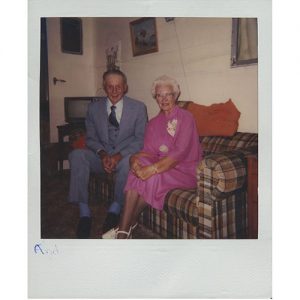 The dye transfer process was introduced in 1963 with “peel-apart” colour film known as instant dye diffusion transfers or instant photography. In 1972, internal dye diffusion transfer prints were invented, which used a chemical process that was entirely self-timing. This became commercially successful for the company Polaroid, which is now the term used for those style of prints. This photo of Andrew and Catherine Kennedy of Tara on their 50th wedding anniversary in 1972 is an internal dye diffusion print.
The dye transfer process was introduced in 1963 with “peel-apart” colour film known as instant dye diffusion transfers or instant photography. In 1972, internal dye diffusion transfer prints were invented, which used a chemical process that was entirely self-timing. This became commercially successful for the company Polaroid, which is now the term used for those style of prints. This photo of Andrew and Catherine Kennedy of Tara on their 50th wedding anniversary in 1972 is an internal dye diffusion print.
To watch an in-depth video presentation about photographic media in the Archives, Click Here

